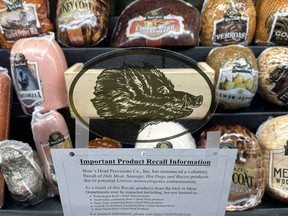
Article content
The Boar’s Head plant in southern Virginia at the epicenter of a deadly nationwide listeria outbreak was regularly cited for violations in the past year, including the presence of mold, mildew, insects and a “rancid smell,” according to reports by government inspectors.
Advertisement 2
Article content
The U.S. Department of Agriculture reports, reviewed by The Washington Post, show that inspectors notified managers at the plant of one or more “noncompliances” on 57 separate days between Aug. 1, 2023, and July 27, 2024. Among the issues cited were “dirty” machinery, flies in pickle containers, “heavy meat buildup” on walls, blood in puddles on the floor, and multiple instances of leaking pipes, clogged drains and heavy dust buildup in certain areas.
The USDA noncompliance citations were first reported by CBS News.
Deli meat produced at the Jarratt, Va., facility between May 10 and July 29 is now believed to be responsible for the deaths of nine people and the hospitalization of dozens of others. The company issued a recall July 29 of everything produced at the Jarratt location in that time frame. At least 7 million pounds of more than 70 products, including ham, bologna, bacon and frankfurters, are part of the recall, according to the Food Safety and Inspection Service of the USDA.
Article content
Advertisement 3
Article content
It is the largest listeriosis outbreak since one in 2011 tied to cantaloupe, the Centers for Disease Control and Prevention said in a statement. Inspections at the Jarratt facility have been suspended, according to the USDA, and the facility will remain closed “until the establishment is able to demonstrate it can produce safe product.”
A Boar’s Head spokesperson said the company is working with food safety experts to conduct an “extensive investigation” into how liverwurst – a sample of which tested positive for the outbreak strain of listeria – was produced at the Virginia facility. The company said its plant team “immediately remediated” noncompliance notifications issued by inspectors.
The USDA didn’t respond to questions about whether inspections at other plants revealed similar issues to those at the Boar’s Head facility, whether a food safety audit was previously conducted, and why operations at the plant weren’t closed sooner.
Advertisement 4
Article content
“We deeply regret the impact this recall has had on affected families. No words can fully express our sympathies and the sincere and deep hurt we feel for those who have suffered losses or endured illness,” a Boar’s Head spokesperson wrote in a statement Thursday.
The repeated violations at the Boar’s Head facility reflect a failed food safety system and raise questions about why the plant was allowed to continue operating in the same manner, said Barbara Kowalcyk, director of the Institute for Food Safety and Nutrition Security at George Washington University.
“The first thing I thought when I read the report is ‘Where is the leadership of this establishment and where are the regulators?’” Kowalcyk said. “When you see repeated violations within days and chronically over that length of time, it suggests that their food safety system is not working as intended. Whatever corrective action is being taken is obviously not being integrated into their system.”
Advertisement 5
Article content
The USDA food safety program is responsible for regulating certain meats such as beef, chicken and pork, and inspectors are required to be on-site at every processing plant, according to Jerold Mande, who previously served in senior food safety positions at both the USDA and Food and Drug Administration.
“Most of what they’re doing is relying on their sight, smell and other things to detect problems,” Mande said. “They could be armed with tools to detect bacteria in real time, but they’re not.” But even with such tools, it’s unclear whether the recent listeria outbreak would have been caught, he added, because the bacteria continues to grow even when refrigerated.
Some food safety experts say the recent outbreak raises questions of whether the meat industry is doing enough to control the risk of listeria and whether USDA inspections are adequate.
Advertisement 6
Article content
“We have food safety regulators because we want them to take action before consumers die,” said Sarah Sorscher, the director of regulatory affairs for the nonprofit Center for Science in the Public Interest. “It shouldn’t take people dying for the plant to take food safety issues seriously; USDA is supposed to be there to ensure that that happens.”
Listeria is the third leading cause of death from foodborne illness in the United States, according to the CDC. It is caused by eating food contaminated with Listeria monocytogenes bacteria. Older adults, pregnant people and those who are immunocompromised are at high risk of the illness.
Federal health officials anticipate seeing additional cases. It can take up to 10 weeks to develop symptoms – such as fever and muscle aches – and some of the products have sell-by dates into October, meaning the deli meats may still be in consumer’s refrigerators and on their sandwiches.
Advertisement 7
Article content
“We continue to monitor for a while after we’ve identified the source to make sure we’ve captured all the illnesses,” said Amanda Conrad, a CDC epidemiologist who focuses on listeria for the agency’s foodborne outbreak response team. The CDC is charged with investigating the illnesses in humans.
Even as agencies continue monitoring for additional cases, Kowalcyk said, there needs to be a follow-up investigation as to why the problem with food safety at the facility lasted as long as it did.
“Why didn’t management take action earlier? Why didn’t the regulators take action earlier?” Kowalcyk asked. “Nine people are dead. When a system fails, you should be doing a root cause analysis to find out why to prevent similar failures in the future.”
Article content




